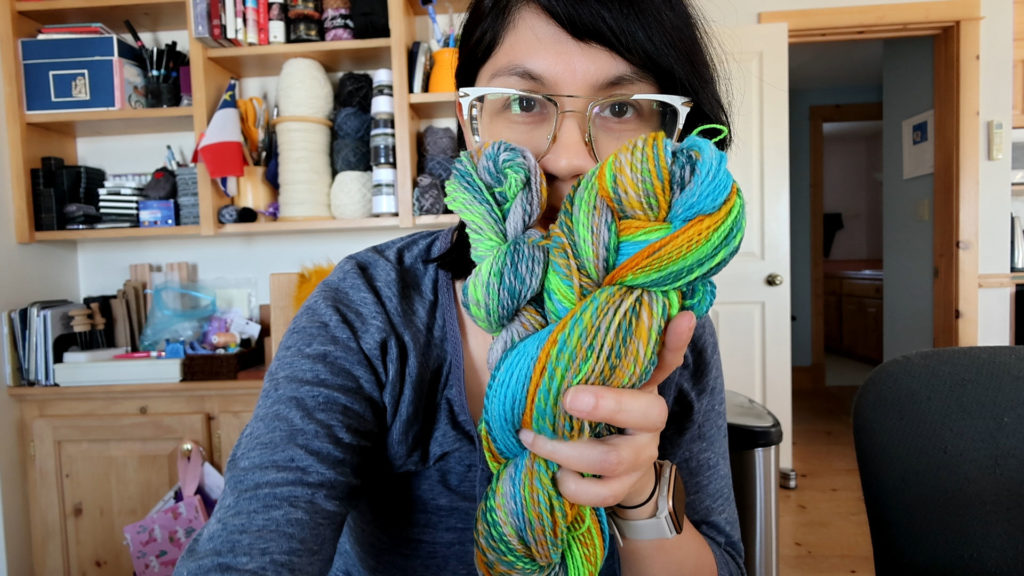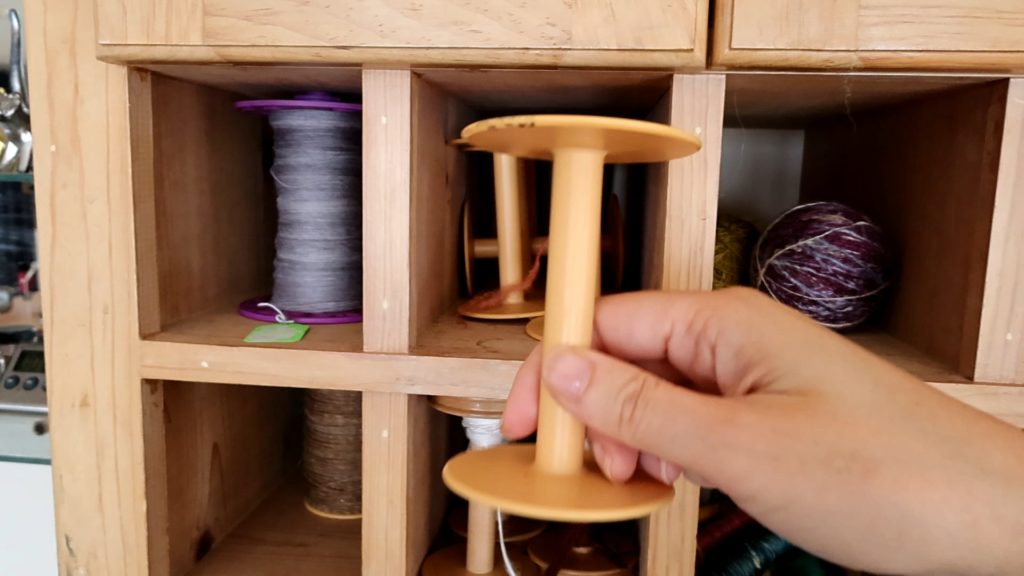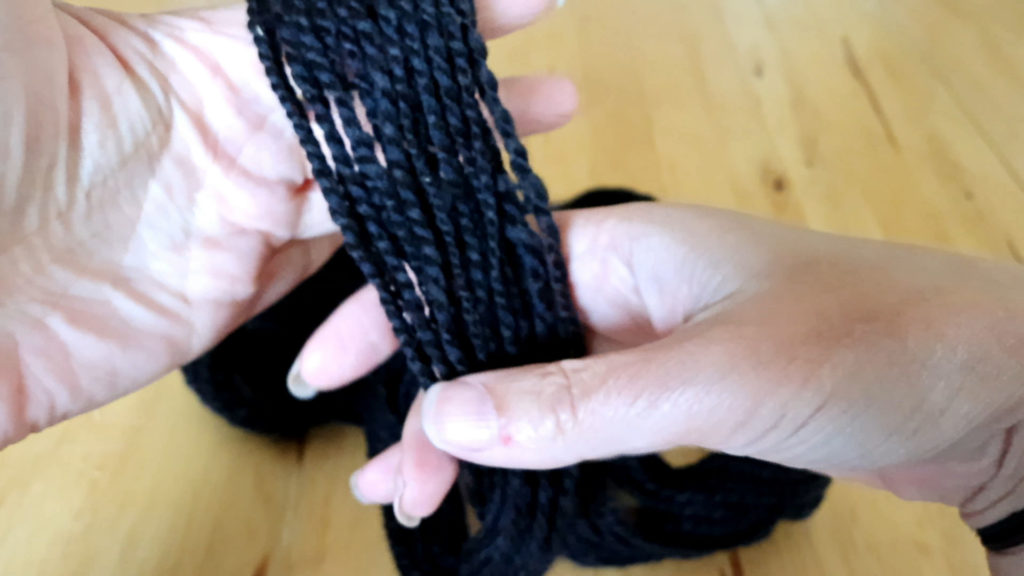A typical 3-ply Handspun Yarn, but not the colors I would typically dye
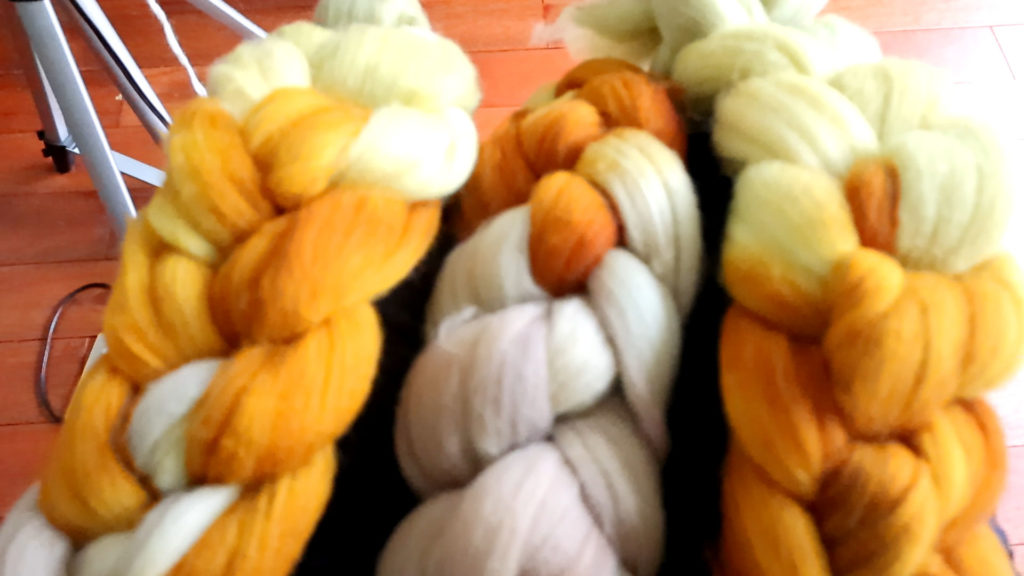
Once again, I began creating yarn and decided, hey, this may make good content for spinning inspiration—or, more specifically, color inspiration. I’m unsure if I captured enough of the process for this to be useful to others, but we’ll put it out there anyway. I know I’m always looking online for new color inspiration for dyeing my fiber for spinning, so why not?
This is your typical 3-ply yarn that I have spun many times, but I hand-dyed some non-typical colors using Merino roving. Well, non-typical for me, anyway! I wanted to go outside my comfort zone of vibrant, deep-saturated colors and use more neutral tones and less saturation.
A couple of years ago, I got into a dyeing tangent, dyeing pairs of rovings the same color. I think I was in the mindset that I wanted to have a decent amount of potential yarn to spin, and if I didn’t use it all, I would sell the braids. I invested in large quantities of roving (commercial top) years ago, mostly targhee and merino, and with the way the price of everything is going today, I am glad I did.
So, this roving challenged me to try out colors that were totally out of my norm. Compared to the usual vibrant roving I prefer to dye and work with, I would call this boring. I have spun more calm, muted colors before, but I can’t say I’ve ever set out to dye a roving with such a neutral palette.
Even then, you could argue that the Aztec Gold is certainly not muted, even with my best intentions dye-wise. Ultimately, I was delighted with the result, and I’ll have to make a note to dye more calm, neutral colors in the future.
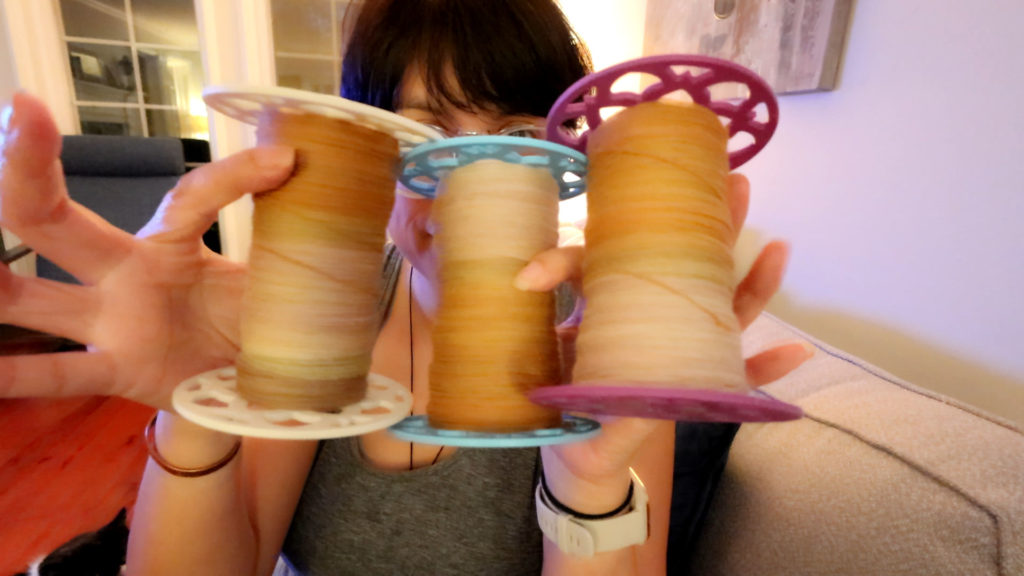
Splitting 2 Rovings into 3
Color is one of many factors when creating yarn. How you will spin that colored fiber is also a big one. I wanted to make a 3-ply yarn since I had two 4-oz braids to work with. I’m so bored with 2-ply handspun and have so much of it spun to go through. I’ve been opting to spin thinner with my e-spinner, making it well-suited to make a 3-ply that will not end up bulky (too many of those, too!). Don’t get me wrong, I still spin 2-ply when I deem fit, but if I can add more 3-ply to my stash, that’s what I want to do.
To make the third singles match the other two, I took a bit of roving one and a bit of roving two by carefully splitting both down the center but off-center so that the third “roving” would be about the same weight as the two remaining. I do this by feel, and sometimes I win the guesstimate lottery, and sometimes I lose. This time, I was off only by a fraction of an ounce, so much like playing yarn chicken and winning, I was pretty happy with that.
Even though I now have two pieces of roving making up my third, I just hold them together and spin like color with like color. It works pretty well if you remember to consistently spin across the two as you hold them. If you start spinning in one area downwards and not across, you can run into the next color and not get a solid block of color. That’s great if you want that effect, but my goal was to spin a self-striping yarn with blocks of color.

How I Dyed This Roving
I dyed this roving in a crockpot, section by section. I weighed out 4oz of Merino top roving, twice. Then, I loosely tied the fiber together, keeping it unbraided. I like to tie the roving together so that it enters the dye in the same place at the same time and will uptake the dye at the same rate. It’s the best chance to get a close to identical color match.
Most of the colors used in this dye combination were Country Classics. Country Classics is an all-in-one dye that requires no mordant. I add the amount of dye to the hot water in the crockpot, dip the desired fiber length in, and let it sit until all the dye is absorbed. If the dye is sluggish to uptake, I add additional boiling water.
For the other acid dye used, Jacquard, I added citric acid to the hot water just before the dye. You can see this process in my post: How To Dye Roving in a Crockpot Step by Step.
Let each color exhaust entirely before adding the next color. I reuse my water as long as it is clear. If some dye remains, you will want to change to fresh hot water. You can add a new color to any non-exhausted dye if you want that effect.
I also measure my powdered dye in small increments and gradually increase it until I get the desired shade. You can always add more dye, but not take away. I like to do this for my notes as well, because if I decide that I want to replicate the dye combo and tweak some of the color I can easily take away or increase the amount of dye to either lighten or darken the shade. This is why you will see 1/3 tsp x3 instead of 1 tsp.
Give your fiber a gentle squeeze to remove some of the water before placing the dyed section into a plastic bin, but don’t try to squeeze all the water out to avoid felting.
Add hot water as needed in between colors, as some of the water will absorb into the fiber as well as evaporates.
The Dye Formula
Section 1: Country Classics Tan, 1/3 tsp x3. (1 tsp total). Mix to dissolve, add fiber to crockpot and stop when you see the uptake color lightening in the fiber.
Section 2: Country Classics Bermuda Sand 1/3 tsp x2, slightly overlapping where the color lightened for section 1.
Section 3: Country Classics Clay 1/3 tsp x2, slightly overlapping where the color lightened for section 2.
Section 4: Country Classics Golden Pear 1/3tsp x2 slightly overlapping where the color lightened for section 3.
Section 5: Country Classics Straw 1/3tsp x2, slightly overlapping where the color lightened for section 4.
Section 6: Add citric acid to the hot water. I don’t measure, but approx. 1/2 tbsp. Then add: Jacquard Aztec Gold 1/3 tsp., slightly overlapping where the color lightened for section 5.
After the Completed Dye
Give the roving a quick soak in the sink with hot tap water and Synthrapol or an equivalent soap like TNA Soap. You can also use blue Dawn dish soap, but use it sparingly, or you’ll be rinsing a lot of suds, and too much manipulation can lead to felting.
You can skip the final soak, as you will be setting your yarn once completed anyway, and that final soak at the completed yarn stage will remove any excess dye. I don’t recommend this for bright or super saturated colors.
Hang your roving to drip dry, preferably outside, but I have done this indoors with a towel and basin underneath to catch the drips. I don’t like to squeeze the water out to prevent felting. You could also run the fiber through a salad spinner to remove excess water. I’m also not a fan of hanging fiber or yarn to dry in the shower or tub because of poor airflow, but if your bathroom has good air circulation, this would be fine.
For me, roving typically dries entirely overnight or at most within 24 hours.
Watch the Video to see Me Creating Yarn
I hope this bit of spinning inspiration is helpful to you on your fiber arts journey. If I can challenge myself to work outside my comfort zone, so can you! This experiment has made me realize that I can create new color favorites if I only push myself to design yarn from colorways I wouldn’t usually choose.
By the way, I’ve caught up to my backlog of content for videos and blog posts and need to film more, mainly showcasing spinning tools, dyeing-spinning techniques, and creating yarn. Right now, I only have time to do one video a month. I have so many ideas but so little time. I hope you enjoy my YouTube channel regardless, and thank you for subscribing if you do! 🙂
I hope you enjoy creating yarn as much as I do.
Until Next time,
I am a jewelry artist, spinner, and indie dyer in Nova Scotia, Canada, self-taught in all areas. I hope these posts help encourage and inspire you along your creative journey, no matter if you approach your craft my way or not. 🙂 Check out my About Me page for more info and the Fiber Arts/Spinning/Dyeing Category for more content like this.


